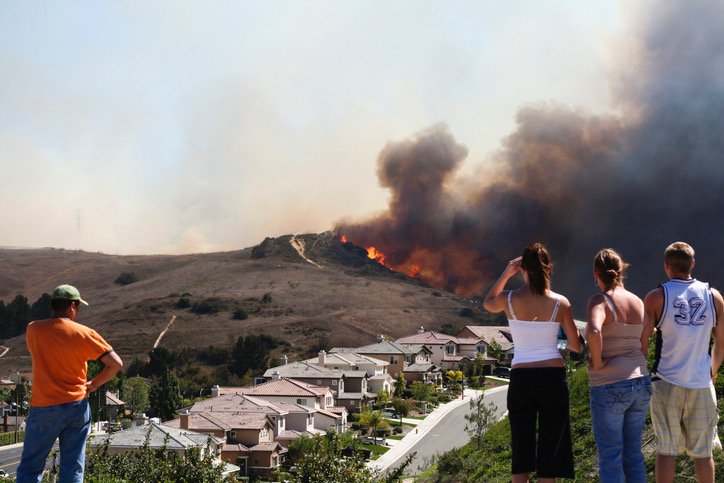Are you ready for fire season?
Many of my clients in Napa, Ojai and Rancho Santa Fe, CA are all well-aware of the fire risks that they deal with each year during fire season, have an emergency plan in-place and are prepared to evacuate when needed. However, many of you who manage luxury properties in areas never deemed high-risk before now need to educate yourselves for this type of emergency preparation.
I managed a beachfront property near Pepperdine University a few years ago – a property that, back then, was not considered in a high-risk fire zone until the Woolsey Fires on November 8, 2018. Now, many luxury properties in that area, as well as many other areas around the country, are under threat of wildfires. And many are no longer able to find insurance coverage – or face insurance rate increases as steep as 500% over previous costs – forcing many to self-insure.
Many luxury homes are located in high-risk areas and face new and evolving challenges. As estate managers, we need to educate ourselves on these ever-evolving challenges and additional responsibilities to protect our employer’s assets and save their families.
Since most estate managers barely have time to handle day-to-day emergencies, let alone create an evacuation plan, you’ll need to schedule time, create a budget, enlist help, inform your employer and get started immediately with these critical tasks.
Here are the vital steps you need to take:
1. Schedule a property visit with your local fire inspector
Complete all suggested changes per their report.
For gated properties, install a Knox box to allow emergency entry into the property.
2. Create a family plan
Sit down with your employers and get them to focus on these critical decisions.
Create procedures for getting out of the house and where to meet.
Set an in-town and out-of-town meeting place if everyone gets separated and can’t communicate.
Create a list of emergency contact list of phone numbers to include:
Family
Neighbors with security gate codes
Hospitals
Doctors
Insurance Agents
Bankers
Develop an animal rescue plan
Horses will need a truck and trailer, predetermined drop location, food and water.
Cats or dogs will need a carrier and leash, as well as food and water supplies listed for the family.
3. Create a staff plan
Get your staff CPR certified and renew when it expires.
Check supplies on a regular basis. Replace expired products.
Take turns announcing 911 drills so that everyone has an opportunity to learn what it takes to be in-charge.
Review procedures and discuss Plan B, C, D to Z scenarios.
4. Create a neighborhood plan
Getting to know your neighbors takes on a whole new meaning if you’re not home during an evacuation and you need their help to save your cat.
Meet with your neighbors.
Exchange contact information.
Exchange gate code information.
Establish a plan that includes everyone’s unique property needs.
5. Create paper maps
House floor plan with fire extinguisher and smoke detector locations
Site plan with utility meters and shut-off instructions, hoses and hose bibs, pumps and additional water sources (wells, cisterns, rain barrels, etc.)
Neighborhood plan with fire hydrants, neighbor’s houses and names and contact information with notes about pets, elderly, valuable fire equipment that can be shared
Regional maps with evacuation routes, emergency facilities, shelters, supply stores, fuel stations, ATMs and meeting places (in-town and out-of-town)
6. Organize your grab-and-go items
Make a list and locate it in a logical location. Purchase what you need to fulfill this necessary list:
Prescription medications
Cash
Fuel
Food, Water and Snacks (including your best bottle of wine) Cooking and Eating Utensils
Pets (leashes, food, meds)
Clothing and Toiletries
Paper Products: Paper Towels, Toilet Paper, and Feminine Products
Trash bags, Ziploc bags
Cooking, Dishware, Personal Sanitation Products and Supplies
Important papers, Checks, Credit Cards, Bank Accounts, Driver’s License, Passports, Extra Keys (for storage and cars), Proof of Residency (with your address)
Tech Equipment:Phone Chargers, Batteries, Solar Chargers, Satellite Phones, Two-way Radios, Radio
Tools, Flashlights, Knives
Blankets
First Aid Kits and Masks
Safe Contents (with the code)
7. Inventory equipment and schedule service
Create an equipment list and schedule testing and regular maintenance.
Obtain proper moving equipment if large items need to be packed and relocated.
Have extra keys for these vehicles, gates, storage units available at all times.
8. Print your emergency plan
Print all of this information, organize it with tabs in a 3-ring binder and produce enough to supply each of your vehicles and buildings with a copy.
Laminate the utilities shut-off instructions and locate copies in the water meter hole, zip-tie one to the gas meter and insert one in the electrical panels.
9. Go online with your emergency plan
This allows you to update information quickly and share it with all who need it
Create a free Trello.com account (or use your favorite online project management system).
Create a board that can be shared with the family, staff and neighbors. This will allow everyone to update new contact information or gate codes without numerous emails or texts.
Upload maps, checklists and contact information.
All of the information will be available on your phone when you’re away from your desk.
Share live communication with your neighbors during a fire event (i.e. Who needs help, where to go for shelter, supplies, fuel, and updates on road closures, etc.)
10. Schedule drills with your employer (including their children)
Determine frequency based on your staff (monthly, seasonal?).
Give everyone the same printed procedures and checklists.
Have them practice using the equipment pumps, extinguishers, etc., and test the AED.
Practice fire procedure drills, CPR and the Heimlich maneuver.
Make sure everyone is aware of the exact location of the supplies, keys, maps, codes, etc.
Everyone will sleep better at night knowing that the family and your staff are prepared and trained, your equipment is available and working properly, and your property is as fire safe as possible to minimize the loss and trauma of living in a high-risk area. Get started now! (And if you need help getting started, get in touch with Kelly here.)
Did this help? Would it help a friend?
Please invite a friend to join our email list and share this post on:
Subscribe to Email | Facebook | Twitter | LinkedIn


